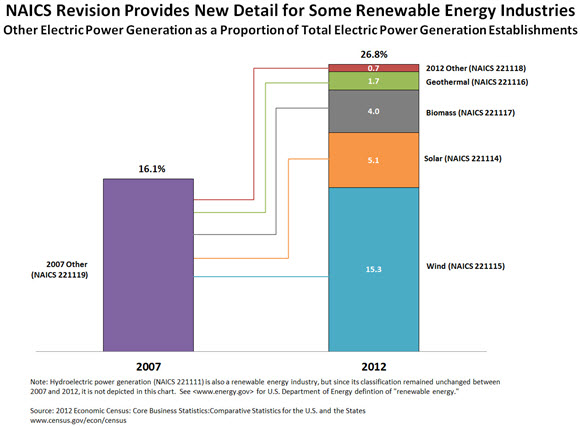Industry Classifications Reflect Changing Economy
Industry Classifications Reflect Changing Economy
The U.S. Census Bureau’s Economic Census has been the official measure of our nation’s businesses and economy since 1810.
The economy changes over time. Recorded music was once primarily on vinyl records. Soon there were 8-track tapes. Those were replaced by cassette tapes and eventually CDs and then downloads. Typewriters were replaced by computer printers and tablets.
Times change and fortunately, we have a system in place that enables us to accurately portray the nation’s rapidly evolving economy in our country’s official statistics. This system is known as NAICS, or the North American Industry Classification System.
The U.S., Canada and Mexico developed NAICS cooperatively in 1997 as the standard for use by federal statistical agencies in classifying business establishments for the collection, tabulation, analysis and presentation of data describing our economy. It replaced the old Standard Industrial Classification (SIC) System. All of our economic census and survey tabulations are categorized using NAICS, which uses a hierarchical structure to classify establishments from the broadest level to the most detailed level.
NAICS codes divide the economy into 20 broad sectors, such as manufacturing, which in turn are separated into 3-digit subsectors (for example, paper manufacturing), which are then divided into 4-digit industry groups (such as pulp, paper and paperboard mills). These industry groups are further subdivided into 5-digit industries (such as paper mills), and then finally into 6-digit industries (like newsprint mills), the most granular level of detail.
The federal interagency Economic Classification Policy Committee, chaired by the U.S. Census Bureau, reviews and revises NAICS every five years. This review takes place prior to the 5—year economic census so that the industries shown in the economic census data accurately reflect the structure of our rapidly changing economy. The updated NAICS categories are then incorporated across other federal surveys..
After soliciting and considering proposals for revisions from the public, the Economic Classification Policy Committee submits recommendations to the Office of Management and Budget, which makes the ultimate decision on changes.
As a result of the review, the committee reduced the total number of 6-digit industries from 1,175 to 1,065. In spite of this net decrease, the committee also added several new and emerging industries, most notably in the utilities sector. Specifically, to reflect the increasing prevalence of businesses that convert renewable energy, the committee split the broad “Other Electric Power Generation” industry (NAICS 221119) into five separate, more specific industries: solar (NAICS 221114), wind (NAICS 221115), geothermal (NAICS 221116), biomass (NAICS 221117), and other electric power generation (NAICS 221118), which includes tidal power. (Hydroelectric power generation is also a renewable energy industry, but its classification remained unchanged between 2007 and 2012.)
In 2007, prior to these revisions, other electric power generation accounted for 16.1 percent of all electric power generation establishments. In 2012, as a result of these revisions, other electric power generation had been reduced to 0.7 percent of electric power generation establishments, with solar comprising 5.1 percent, wind 15.3 percent, geothermal 1.7 percent and biomass 4.0 percent.
Other revisions to NAICS involve merging some industries into new, broader industries. Such was commonly the case in the manufacturing sector.. For example, “electric housewares and household fan manufacturing” and “household vacuum cleaner manufacturing” were merged into the “small electrical appliance manufacturing” industry (NAICS 335210). In another case, four industries ─ “pen and mechanical pencil manufacturing,” “lead pencil and art good manufacturing,” “marking device manufacturing,” and “carbon paper and inked ribbon manufacturing,” were combined into “office supplies (except paper) manufacturing” (NAICS 339940).
Reflecting the decline of smaller, specialized stores and the rise of “big box stores,” “radio, television, and other electronics stores;” “computer and software stores;” “camera and photographic supplies stores;” and “prerecorded tape, compact disc, and record stores” were merged into the broad “electronics stores” industry (NAICS 443142). The four now-defunct industries had 27,435; 10,428; 1,988; and 4,153 stores, respectively, in 2007. There were 40,521 electronics stores in 2012.
Our economic census “Bridge Report” details all these changes by presenting 2012 data for these industries whose NAICS classification changed between 2007 and 2012. A related data set, the “Comparative Statistics Report,” converts the 2012 data into 2007 NAICS codes to permit “apples to apples” comparisons with the 2007 data.
Looking ahead, the Economic Classification Policy Committee has already made recommendations for changes to NAICS for the 2017 Economic Census, which the Office of Management and Budget finalized in August. As in 2012, in some cases, broader industries will be split into multiple new industries. In other cases, several declining industries will be collapsed into one or eliminated and scattered among multiple industries.
For instance, the current crude petroleum and natural gas extraction industry will be split into two new, separate industries for crude oil extraction and natural gas extraction to more clearly reflect the growth in gas extraction. On the other hand, four manufacturing industries ─ “household cooking appliance,” “household refrigerator and home freezer,” “household laundry equipment” and “other major household appliance” ─ would be combined into a broader “major household appliance manufacturing” industry. Another industry ─ “discount department stores” ─ would disappear, with stores that were categorized in this industry and having insignificant perishable grocery sales being moved into the “department stores” industry, and those with significant perishable grocery sales being placed in the “warehouse clubs and supercenters” industry. These changes will be rolled out as the Census Bureau begins to collect 2017 Economic Census data next year, with the new data scheduled to be published beginning in 2018.
As America’s economy continues to grow more diverse and complex, NAICS will be revised accordingly to help ensure Census Bureau data reflect our ever-changing U.S. economy.
The Economic Census is conducted every five years: in those ending with a “2” or “7.” The recent publication of a series of reports on mining concludes the release of findings from the 2012 Economic Census.




